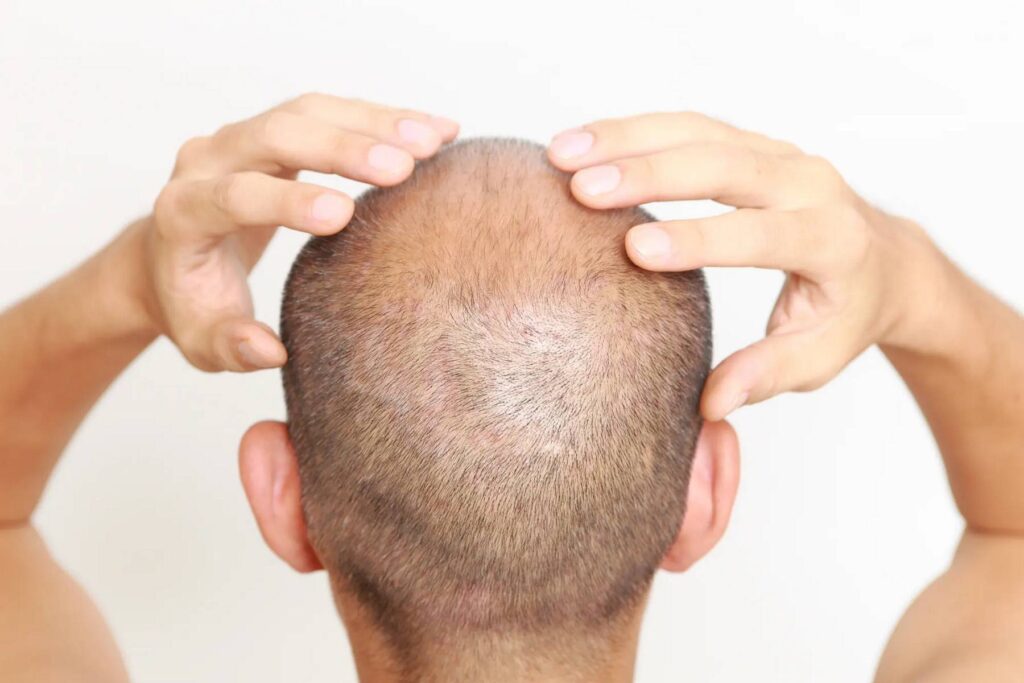
At first glance, hair transplantation may seem like a purely cosmetic procedure, but it is actually a physical and mental investment in the future that requires careful planning and donor area management.
Hair loss is often a progressive process that can lead to severe baldness over time. Focusing solely on short-term solutions during this process may result in new issues arising in the future. Therefore, anyone considering hair transplantation should evaluate the process not only in terms of the “number of grafts to be transplanted” or “front hairline design,” but also in terms of long-term hair health, donor capacity, and possible second sessions.
In this article, we will discuss how to make the hair transplantation process more useful, achieve permanent results, and extend the future of this process over a longer period of time.
İçindekiler
What is the Donor Area and Why is it So Important?
The donor area is the region at the back of the head, typically defined as the nape of the neck and behind the ears, where genetically resistant hair follicles are located. In hair transplantation, grafts (i.e., hair follicles) are taken from this area and transferred to sparse regions.
However, it is important to note that this area is a limited resource. Uncontrolled and improper practices can deplete this resource. If the donor area becomes excessively thin as a result of an incorrect transplant, it will not only create an uneven appearance, but also eliminate the possibility of a second or third transplant in the future. Therefore, the donor area should be considered a “resource” and used sustainably. For this reason, the donor area is of great importance in the transplant process.
Think About the Future of Your Hair
Most people who undergo hair transplantation focus solely on correcting their current hair loss. However, especially in people with male pattern baldness, this condition usually progresses over time. Someone who only experiences hair loss on the crown at age 30 may lose both the crown and the frontal hairline by age 40. In such cases, a second hair transplant may be necessary. If the donor area was not utilized properly in the first procedure, addressing these issues becomes more challenging. Finding solutions for new hair loss becomes nearly impossible.
A successful and experienced surgeon anticipates potential complications in the process and considers not only current but also future hair loss possibilities. In this regard, hair transplantation should be viewed not merely as an “aesthetic procedure” but as a “long-term investment in hair health.”
What Factors Affect the Preservation of the Donor Area?
- Planning the Number of Grafts According to the Individual
Each individual’s donor capacity is different and requires personal planning. While 5,000 grafts can be taken from one person, 2,500 grafts may be sufficient for another. Factors such as hair structure, density, diameter, and waviness determine this capacity. A specialist evaluation is important to better understand these factors. The goal at this stage is not to obtain the highest number of grafts but to achieve the most natural result with the correct number of grafts. - Balanced Distribution of Grafts
Taking grafts from various areas rather than a single area reduces the risk of thinning in that area. Thinning in this area can damage the integrity of the transplantation process and create visual imperfections. Therefore, grafts should be taken from different points on the back of the head and distributed evenly. This balanced approach is also extremely important for achieving natural results. - Acting with the Possibility of Repeat Transplantation in Mind
Although a single session of hair transplantation may be sufficient, in some individuals, hair loss may continue after the transplantation. This may require a second transplantation. Therefore, instead of using the entire capacity of the donor area in a single session, it is important to leave a certain amount of “spare grafts” for future procedures.
Are There Any Alternatives for Those Experiencing Donor Area Loss?
Yes, the following alternatives may be useful, especially for individuals with weak donor areas:
- Body Hair Transplantation (BHT): Grafts can be taken from chest, beard, or back hair to support transplantation. However, the condition of the hair follicles must be evaluated for this method.
- Hair Simulation (Micropigmentation): This may be effective for some individuals to camouflage density deficiencies.
- Hair Mesotherapy and PRP: These help strengthen the donor area and protect existing hair.
What Should Be Considered in Long-Term Planning?
Before deciding on hair transplantation, it is important to understand the current condition of your hair in order to have realistic expectations and ensure that the results are as you expect. It is important to ask the following questions before starting this process:
- What is the capacity of my donor area?
- If my hair loss process progresses, will I need a second transplantation?
- Will the number of grafts be sufficient to achieve a natural appearance?
- How many years will it take for the results to remain satisfactory?
- Will there be any scars or thinning in the donor area?
Obtaining honest and realistic answers to these questions will protect you from disappointment and dramatic results. Because the outcomes depend not only on the surgeon’s experience but also on your personal hair structure.
Ensure Your Donor Area Is Used Wisely

Hair transplantation is a delicate and important process that causes changes in the individual. Therefore, it does not end with just “the transplantation was done today.” This process requires patience and a delicate approach.
One of the most critical elements of this process is the wise management of the donor area. A well-planned transplant will not only be aesthetically satisfying but will also give you an advantage for any future procedures you may need. This will be the guarantee of your future hair health.
Remember, hair transplantation is not just a procedure; it is a journey of change that requires careful planning, the right technique, and a long-term perspective.
Hairtrans.com was founded by world-famous plastic surgeon Dr. MFO, who is an expert in facial feminization or facial masculinization surgeries, and is managed under his leadership. Would you like to have a hair transplant under the coordination of a plastic surgeon with many years of experience?
Whether you are a trans woman or a natural born male or female, if you are looking for the best hair transplant, contact us now.


